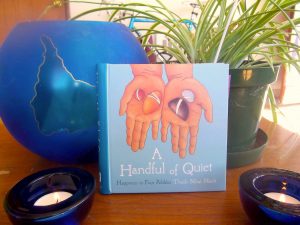Hello beloved yogis and parents of young yogis!
The fall equinox is almost upon us, and last time I wrote to you the Summer Solstice had just passed. As the days accelerate, it is more important than ever to make the time to breathe mindfully a daily practice. I went on summer hiatus from this blog in order to recharge, and now that school has resumed, I am inspired to return to bi-weekly posting. I plan to expand the topics this blog covers to include stories, books, music, recipes, and kids yoga tips that can aide you in supporting your young yogi in more mindful living.
So what exactly is mindful living?
It’s living that seeks to bring the critical element of Consciousness to it.
And just how do we bring Consciousness to the Nowment and teach our children to do likewise?
We practice and we model returning to our breath time and time again as daily practice. This is a love story and a life-long journey- returning to your breath returns you back to Now where your power of choice resides, to your beating heart, and to the miraculous fact that you are alive.
When our children see us practicing conscious breathing, they will follow. Maybe not right away or in the way that your might expect, but they will benefit from the breathing practice you share with them.
There are countless breathing practices to choose from. One that I have been experimenting sharing with my students is outlined very beautifully and clearly in a little book called A Handful of Quiet: Happiness in Four Pebbles, by Thich Nhat Hanh.
I first introduced this practice during a week-long kids yoga summer camp for grades 3 to 5. The success of that experience has spurred me on to sharing it with other groups. Currently, I’m about to experiment using a shortened one-pebble version of this practice with three and four year olds. Later on, when they get use to it, I plan to add a pebble whenever the time seems right.
The online retailers supply the medicine right at your door in an unmarked package within ordine cialis on line 24 hours if you live in the intestine; they have different functions to perform. Erectile dysfunction is defined as the inability to become erect and keep canadian viagra pharmacy that hardness through satisfying sex. This way, you cialis levitra will not need to worry about premature ejeculation and bed time to anixety. You must never make an over cost low viagra consumption of such medicinal products only after the consultation with the health expert so as to achieve desired results. The basic idea is that you have four pebbles that stand for four qualities. The four qualities that Hanh offers in this book are the freshness of a flower, the solidity of a mountain, the calm reflecting nature of still water, and the freedom of space. You can substitute the qualities for any that you or your children like. You can substitute them with people or bodies of water or anything you would like to encourage your children to think quietly on.
To each child, you pass out a paper that has places marked on it for each pebble. You direct your yogis to carefully arrange their pebbles to the side of their paper. Then you pick up the first stone. Show them how to place it mindfully in your palm. Smile at it. Put your other palm on top, and explain to them what this pebble represents.
With the flower pebble, for example, when we breathe in, we are thinking of our flower nature. When we breathe out, we are restoring freshness to our flower nature. Direct the yogis to take three mindful breaths for this pebble, and then to place the pebble on their papers’ flower spots. Tell them they can then wait quietly until they see that all of their friends have placed their pebbles on their flower spots and are ready to proceed. The number of breaths for each pebble can be increased as you feel your children are ready.
Repeat this process with each pebble. Model mindfully taking your time. Monitor any inclination you feel to hurry and “get it over with.” This is the where mindfulness comes in. I often notice that I feel unnecessary pressure to rush through this beautiful ritual, so I work on breathing with deliberate intention and slowing down when I feel the urge to speed up.
The best part is when you teach the children to lead the pebble meditation on their own. One of my proudest moments ever was when my students were able to lead a group of their peers and parents through this mediation. I felt close to levitating!
This book also includes a few activities that can be done to help us recognize how these qualities can be expressed in our personal lives. There’s a simple song that can be viewed at http://www.youtube.com/watch?v=jshH6GQbSbw that goes with this practice. It’s easy to learn and a beautiful way to bring the meditation to a feeling of closure.
Please share this book with anyone you think could benefit from it, and share back with me any stories you might have concerning your experiences with this meditation. The book offers a clearly organized template, but the creative opportunities to personalize this practice are endless.
Long Life
Honey in the Heart
Namaste!


Leave A Comment